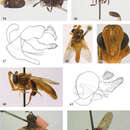Systematics or Phylogenetics
provided by EOL authors
Thompson et al. (1976) reduced the group to a subgenus of Microdon based on the bifid aedeagus.
Ceriomicrodon: Brief Summary
provided by wikipedia EN
Ceriomicrodon is a genus of hoverflies. The only known species, Ceriomicrodon petiolatus, lives in the Brazilian states Mato Grosso, Roraima, Amazonas, Maranhão and Rondônia. Its biology is poorly known, but the larvae are assumed to live in ant nests. Only a few specimens were known of the species until 2014, when the species was redescribed.
- license
- cc-by-sa-3.0
- copyright
- Wikipedia authors and editors
Description
provided by Zookeys
Body length: 11 mm. Very slender, wasp-like flies with long antennae and constricted abdomen. Face convex, somewhat produced on ventral half; narrower than an eye. Lateral oral margins clearly produced. Vertex flat. Occiput ventrally narrow, dorsally somewhat widened. Eye bare; frontally with narrow, horizontal area of enlarged ommatidia at level of antenna. Eyes in male strongly convergent at level of frons. Antennal fossa about 1.5 times as wide as high. Antenna longer than height of head; basoflagellomere more than twice as long as scape; bare. Postpronotum bare. Anepisternum with shallow sulcus; pilose along posterior margin and sparsely anterodorsally, widely bare in between. Anepimeron entirely pilose. Katepimeron flat; bare. Scutellum semicircular; without calcars. Wing: vein R4+5 with posterior appendix; vein M1 perpendicular to vein R4+5; postero-apical corner of cell r4+5 widely rounded; crossvein r-m located around basal 1/3 of cell dm. Abdomen very slender, constricted at tergite 2. Tergite 2 longer than thorax, about as long as tergites 3-5 together. Tergites 3 and 4 fused. Male genitalia: phallus furcate near apex, with dorsal process long and whip-like, ventral process very short; epandrium with ventrolateral ridge.
- license
- cc-by-3.0
- copyright
- Menno Reemer, Gunilla Ståhls
- bibliographic citation
- Reemer M, Ståhls G (2013) Generic revision and species classification of the Microdontinae (Diptera, Syrphidae) ZooKeys 288: 1–213
- author
- Menno Reemer
- author
- Gunilla Ståhls
Distribution
provided by Zookeys
Described species: 1. Known from Central (Mato Grosso) and Northern Brazil (Roraima).
- license
- cc-by-3.0
- copyright
- Menno Reemer, Gunilla Ståhls
- bibliographic citation
- Reemer M, Ståhls G (2013) Generic revision and species classification of the Microdontinae (Diptera, Syrphidae) ZooKeys 288: 1–213
- author
- Menno Reemer
- author
- Gunilla Ståhls

